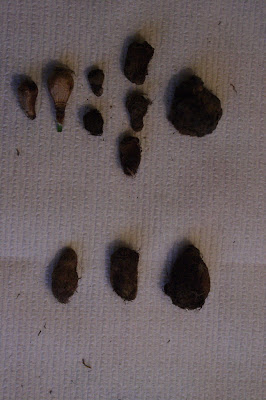An early February thread on the Pacific Bulb Society discussion group touched briefly on aquatic crinum. At first the focus was on
Crinum thaianum, a species described on the one hand as endangered and on the other hand as readily available in the aquarium trade. Eventually it was mentioned that dry bulbs for aquarium plants were being sold in some shops - not as actively growing plants but as dry bulbs sold in a clamshell package. This really got my attention, so off I went to two local aquarium stores.
At the first shop I asked for
Crinum thaianum and got a blank stare. But then the cranial bulb began to flicker, and the aquarium guy said something about "crinium". Off we went to check out the selection. They did have an African species with decorative foliage, but not
C. thaianum. And their plants were in active growth, not dry, dormant bulbs.
At the next shop, my first impression was dismal. Things didn't seem too promising. That's because my aquarium sensibilities never advanced much beyond 1960. After looking around for a bit and not seeing anything, I finally asked. A query about
Crinum thaianum brought no response, but when I mentioned "bulbs" I was ushered into what for me was a new world. We walked away from the aquariums and instead he left me in front of a display rack/shelf of the sort you might see in any dry goods store. He pointed, and I didn't see. But I was looking right at them. There they were, row after row of little plastic clamshell containers each of which held what at first glance looked to be little oval lumps of dry dirt.
My first thought: these are alive? I was assured that they were. So I bit: I bought one box of the "Betta Bulbs" and one box of the three-in-one combo. As soon as I got home I took some photos and then got the bulbs into water. That most of them floated like corks was not encouraging. I decided to save the boxes with their guarentee and the address to which I could apply for a refund.
Now fast forward about a month and a half: the Betta Bulbs, which were identified on the box as a species of
Aponogeton, have not only surged into growth but are blooming! The sweetly scented flowers are nothing to look at, but this whole affair is certainly interesting.
I have no idea which
Aponogeton these are. IPNI lists 142 names assigned to this genus, and the Wikipedia entry suggests that there are between 40-50 species. The branched inflorescence suggests that of the southern African
A. distachyos (distichous in English means in two rows or segments), but the individual flowers are not as conspicuous.
A. distachyos is sometimes available in the ornamental pond trade, and has a long history of cultivation in England. The Missouri Botanical Garden site suggests that it will survive in ponds in USDA zone 6 climates as long as the tubers do not freeze.
I vaguely remember that when I was a teenager I obtained some of these dry
Aponogeton tubers and sprouted them.
The three images at the top are of the "Betta Bulb"
Aponogeton. Of the three obtained, one is in bloom, one is about to bloom - so maybe I'll get seed. Then there are two images of the clamshell boxes, and finally a line up of the items in the box. Of these, the bottom three are the Betta Bulb
Aponogeton. The ones in the upper row are problematic, but the two on the left might be
Zephyranthes candida (a suggestion from a PBS member), the five in the middle are probably more
Aponogeton, and the one on the left might be a
Nymphaea (waterlily). We'll see - or maybe we won't, because the maybe-waterlily is hard and floats like a piece of wood.









